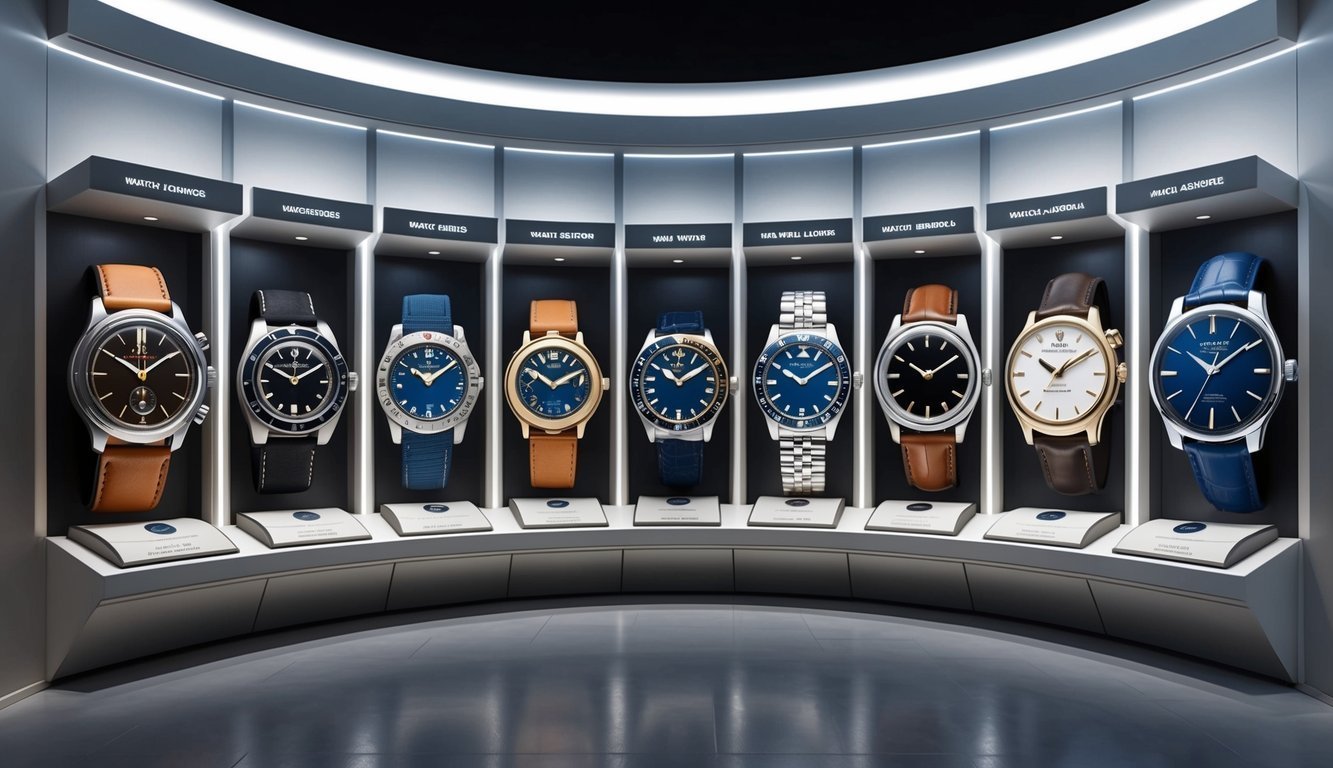Watchmaking has a rich history that reflects human ingenuity and artistry across centuries.
As styles and technologies evolved, various brands emerged, each contributing unique design aesthetics and innovations to the world of horology.
Exploring these brands gives you insight into how timepieces evolved from simple tools into luxurious symbols of status and craftsmanship.

Whether you’re a seasoned collector or just starting your journey into the world of watches, there’s so much to discover.
From the classic elegance of Swiss craftsmanship to modern technological advancements, these brands have a story to tell and innovations to showcase.
Each one offers a glimpse into the passion and precision that defines the art of watchmaking.
Patek Philippe Nautilus

The Patek Philippe Nautilus is a true icon in the world of luxury watches.
Launched in 1976, it was designed by the famous watchmaker Gerald Genta, making waves with its unique approach to sports watches.
With its distinctive porthole case and integrated bracelet, the Nautilus stands out from traditional dress watches.
It combines elegance with a sporty feel, allowing it to fit various occasions.
The original model, the Nautilus 3700/1A, featured a large stainless steel case, measuring 42mm, and a slim profile.
This watch is known for its exquisite craftsmanship, showcasing Patek Philippe’s commitment to quality.
Over the years, the Nautilus has evolved, introducing various models that retain its signature style.
Its blend of luxury and sportiness has made it a collectible piece, sought after by watch enthusiasts and collectors alike.
You might appreciate that the Nautilus is not just a watch; it’s a statement piece.
It’s celebrated for its timeless design and impressive mechanics, making it a noteworthy addition to any watch collection.
2) Rolex Submariner
The Rolex Submariner has been a staple in the watchmaking world since its debut in 1954.
It originally aimed to cater to divers, combining ruggedness with a touch of luxury.
The first model featured a distinctive matte-black dial and a rotating bezel, making it functional yet stylish.
Over the years, it has seen several updates, like the introduction of crown-guards in 1959 and the shift to sapphire crystal in 1979.
Collectors and enthusiasts admire how the Submariner balances performance with aesthetics.
Its reputation has grown, making it a sought-after watch, whether you are a diver or just a fan of fine timepieces.
Today, the Submariner is an icon of both luxury and engineering, loved by many for its versatility.
Omega Speedmaster

The Omega Speedmaster is a true icon in the watchmaking world.
Introduced in 1957, it quickly gained a reputation for precision and durability.
You might recognize it as the first watch worn on the moon.
Buzz Aldrin sported it during the Apollo 11 mission, making it a piece of history.
The Speedmaster has seen several iterations over the decades.
Each model builds on the legacy of its predecessors, showcasing advanced technology and design.
From its original Calibre 321 to modern iterations, the Speedmaster remains a favorite among collectors.
It’s versatile enough for both casual and formal settings, making it a great addition to your collection.
Whether you’re a watch enthusiast or a casual observer, the Speedmaster’s story is captivating.
Its blend of style and functionality keeps it relevant today, appealing to a wide range of tastes.
Audemars Piguet Royal Oak
The Audemars Piguet Royal Oak is a game changer in watch design.
Launched in 1972, it broke the mold with its bold approach, combining luxury with a sporty aesthetic.
You might recognize its octagonal bezel and integrated bracelet.
These features set it apart from traditional round watches and marked a new era in horology.
The Royal Oak quickly became an icon.
Over the years, the collection has expanded significantly.
Audemars Piguet has introduced various models catering to different tastes and sizes, including pieces designed specifically for women.
The Royal Oak “Jumbo” Extra-Thin is a standout.
Its revival of the original blue dial color, “Bleu Nuit, Nuage 50,” pays homage to its roots while remaining modern.
Audemars Piguet’s commitment to craftsmanship is evident in every model.
They offer both simple and extremely complicated timepieces, proving that the Royal Oak is much more than just one watch—it’s a whole collection that continues to evolve.
5) Tag Heuer Carrera
When you think about the evolution of watchmaking, the Tag Heuer Carrera stands out.
Launched in 1963, this line was designed for motorsports enthusiasts and has become a symbol of precision.
In the late ’60s, Tag Heuer revolutionized the industry by creating the world’s first automatic chronograph movement, the Calibre 11.
This innovation set new standards in watchmaking.
Fast forward to 2012, and the Carrera brand made waves with the Mikrogirder.
This mechanical chronograph could measure time to 5/10,000th of a second, showcasing Tag Heuer’s commitment to technical excellence.
The brand has consistently pushed boundaries, merging classic design with groundbreaking technology.
Whether you’re a casual wearer or a collector, the Carrera offers something for everyone.
It’s a piece that not only tells time but also carries a rich history in watchmaking.
With its blend of style and performance, wearing a Carrera is like having a piece of motorsport on your wrist.
6) Breitling Navitimer
The Breitling Navitimer is a true legend in the world of pilot’s watches.
Introduced in 1952, it’s known for its distinctive slide rule bezel, which helps pilots perform essential calculations.
This watch combines style with functionality.
The Navitimer B01 Chronograph features a 43mm case, automatic movement, and is available in various price ranges, making it accessible to many enthusiasts.
The classic design reflects both history and innovation.
With options like the Navitimer ref 806 1959 Re-Edition, you get a touch of nostalgia with modern performance.
Breitling’s dedication to aviation is also evident in the limited editions that pay tribute to historic airlines.
So, if you’re looking for a watch that stands out while offering utility, the Navitimer is a solid choice.
7) Cartier Tank

The Cartier Tank is a timeless classic that has been a favorite since its introduction in 1917.
Its design was inspired by the Renault FT tank used in World War I, showcasing a unique rectangular shape that set it apart from other watches.
You’ll find that the Tank has evolved over the years with various iterations, like the Tank Must.
Launched in 1977, this model made the Cartier Tank more accessible, featuring a quartz movement and a gold-plated case.
Cartier’s commitment to craftsmanship is evident in the materials and design.
The watch combines elegance and functionality, making it suitable for both formal and casual occasions.
Each version retains the iconic Roman numerals and blue cabochon crown.
These details ensure that whether you choose a Tank Louis Cartier or a Tank Anglaise, you’re getting a piece of horological history that remains relevant today.
8) IWC Portofino

The IWC Portofino collection is all about elegance and style.
Launched in the 1980s, these watches focus on a classic design that’s meant to last.
You’ll notice the simplicity in its aesthetics, which make it suitable for almost any occasion.
The collection features various models, including ultra-thin and chronograph versions, showcasing fine Swiss craftsmanship.
In 2015, IWC gave the Portofino a significant update, refreshing its design while maintaining that timeless charm.
The new models feature clean lines and refined details that enhance their sophisticated appeal.
One standout piece is the Portofino Perpetual Calendar in an 18k red-gold case.
It combines function and form beautifully, measuring 40mm in width.
Whether you’re a watch enthusiast or someone looking for a stylish accessory, the Portofino collection has something to offer.
Its blend of tradition and modernity makes it a must-see in the world of luxury timepieces.
9) Seiko Grand Seiko

When it comes to watchmaking, Seiko and its luxury line, Grand Seiko, are essential names to explore.
Seiko has a rich history that dates back to 1881, and it’s known for its precision and innovation.
Grand Seiko is all about high-end craftsmanship.
The brand was established in 1960, focusing on creating watches that reflect both artistry and technology.
Each timepiece is meticulously designed, emphasizing intricate details.
Seiko’s commitment to excellence is evident in their movements, like the Spring Drive, which combines mechanical and quartz technology.
This innovation provides remarkable accuracy and a unique glide motion of the second hand.
You’ll also find that the designs pay homage to Japanese culture, with dials that often reflect natural elements, showcasing beauty alongside functionality.
If you want to explore a blend of tradition and modern watchmaking, Seiko and Grand Seiko are definitely worth your attention.
10) Longines Master Collection

The Longines Master Collection is a blend of elegance and tradition.
This line showcases the brand’s expertise in watchmaking, featuring both intricate complications and simple designs.
You’ll find automatic timepieces crafted with high-quality materials.
Stainless steel and 18 karat gold are common, providing a luxurious feel.
Since its launch in 2005, the collection has undergone updates, including new engraved dials and unique numerals.
These enhancements give the watches a fresh appeal while maintaining their classic charm.
Longines has a history of innovation in the industry.
The Master Collection reflects this legacy, offering reliable functionality that matches its stylish appearance.
Whether you prefer a sophisticated or understated look, this collection has something for you.
History of Watchmaking

Watchmaking has a rich history marked by significant innovations and developments.
This journey from early timekeeping devices to intricate mechanical watches reveals the craftsmanship and technological advancements that shaped the industry.
Early Innovations
The roots of watchmaking date back to ancient timekeeping methods.
Egyptians used sundials and water clocks to track time.
However, the real game-changer began in the 15th century with the advent of large wall clocks in Europe.
By 1510, Peter Henlein crafted the first portable clocks, known as miniature clock watches.
These spring-powered devices offered better convenience.
This shift laid the groundwork for the evolution of personal timepieces.
As the demand grew, artisans started refining their techniques, leading to the creation of more accurate and decorative pieces.
This period set the stage for future innovations that would push boundaries.
The Rise of Mechanical Watches
Mechanical watches began to gain popularity in the 17th century.
The introduction of the balance spring, invented by Christiaan Huygens, improved accuracy significantly.
This innovation meant that watches could keep time more reliably than their predecessors.
In the 19th century, the industrial revolution brought mass production techniques.
This allowed brands like Patek Philippe and Cartier to emerge as major players, focusing on both functionality and luxury.
Mechanical watches transitioned from simple tools to status symbols, reflecting the wearer’s taste and lifestyle.
The craftsmanship of these timepieces made them coveted items, ushering in a new era of watchmaking that continues today.
Technological Advancements

Watchmaking has seen transformative technological shifts that have redefined the industry.
These advancements have enhanced precision and broadened functionalities, making watches more than just timekeepers.
Quartz Revolution
The introduction of quartz technology in the 1970s marked a significant turning point.
Quartz movements use a battery and a tiny crystal to achieve high accuracy, outpacing traditional mechanical movements.
- Advantages:
- Higher accuracy
- Lower maintenance costs
- Affordability
Brands like Seiko were pioneers, providing accessible quartz watches that changed consumer expectations.
This revolution led to the rise of digital displays, enabling new styles and functionalities.
The once-prestigious mechanical watch market faced intense competition, but it also sparked a revival of craftsmanship in response to the growing popularity of quartz.
Smartwatches and Modern Innovation
The advent of smartwatches has pushed the industry forward.
These devices blend traditional watchmaking with cutting-edge technology.
Features include fitness tracking, notifications, and customizable interfaces.
- Key Players:
- Apple Watch
- Samsung Galaxy Watch
- Garmin
Smartwatches utilize apps and sensors, allowing for a level of interactivity previously unseen in watches.
They cater to a tech-savvy audience, merging style with functionality.
As they integrate with smartphones, the possibilities seem endless.
It’s not just about telling time anymore; it’s about enhancing your daily life.


